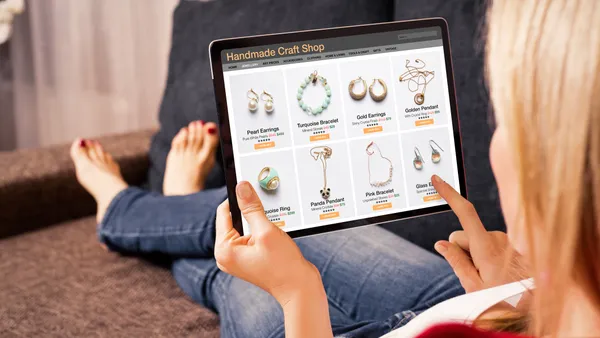Editor's note: The following is the second installment in Retail Dive's Consumer Survey, a six-part series examining the psyche of the American consumer and the evolving role of the brick-and-mortar store in the shopping journey. Check out all of our results on our landing page.
Let any doubt about the disruptive nature of digital shopping be laid to rest.
It’s no secret that Amazon’s e-commerce and delivery innovations are eating into traditional brick-and-mortar market share — and if retailers can’t keep up, they stand to lose shoppers who are increasingly inclined to browse and buy online.
Consumers have spoken, and they say they’re more likely to shop for almost all types of products online instead of in stores, according to Retail Dive’s Consumer Survey. For the second question in a six-part series looking at consumer shopping habits, we surveyed 1,010 U.S. consumers via Google Surveys about the types of product categories they’re more likely to shop for in stores than online.
Results indicate that plenty of shoppers are using the internet as their go-to shopping source. These findings are in accord with a recent study by Deloitte Consulting claiming that digital devices now influence 56 cents of every dollar spent in physical stores. In fact, out of the six categories we asked about, brick-and-mortar stores took the lead in just one category — household essentials. Roughly three out of every five consumers say they’re more likely to shop for household essentials, such as groceries, in stores versus on the web.
But other product categories studied have already hit the online tipping point. Even home furnishings are going digital, with 48% of consumers saying they’re more likely to shop for those products in stores versus online. Meanwhile, online shopping is the clear winner in apparel and accessories, electronics and appliances, entertainment, and personal care and beauty products. For these categories, fewer than two in five consumers say they’re more likely to shop in stores than online.
While consumers overall are increasingly turning to digital shopping, differences exist between ages and genders. Generally speaking, shoppers in the 35-44 year age range are the least likely to shop in stores for several categories. Meanwhile, younger (18-24) and older (65+) consumers lean more heavily toward in-store shopping.
A handful of minor differences also exist between genders. A higher share of women say they’re more likely to shop for personal care and beauty products in stores. When it comes to electronics and appliances, more males shop in stores versus the web. That probably has something to do with the “try-it-before-you-buy-it” attribute of in-store shopping.
Here's a closer look at consumer habits when it comes to deciding between in-store and online shopping.
Online or offline? Depends on the product
As discussed in our first installment of the Retail Dive Consumer Survey, brick-and-mortar shopping is still preferable when shoppers need to touch, feel and try out items before they buy them. Stores remain the preferred shopping channel for household essentials in particular, according to the results of our second survey installment.
Since grocery shopping involves a major convenience and immediate consumption component, going to the supermarket isn’t that big of a deal for most shoppers. In fact, Wal-Mart has stated that 90% of Americans live within 15 minutes of one of its stores.
When it comes to buying food, many shoppers still prefer to pick out their groceries, rather than have an e-commerce fulfillment specialist — a store “picker” or even a robot — do the job. But like any other category, online shopping for groceries is likely to gain traction in the coming years, especially if Amazon has any say in the matter. According to new statistics from the Food Marketing Institute and Nielsen, online grocery spending is expected to reach $100 billion by 2025 while the percentage of shoppers doing their grocery shopping online is estimated to more than double. By 2025, 72% of all shoppers are projected to conduct 25% of their grocery shopping online.
Of the categories in our study, consumers said they were least likely to shop for entertainment items like books and movies in stores. That's to be expected: Digital media and streaming are the new normal for the vast majority of shoppers these days. Just 15% of consumers say they’re more likely to shop for entertainment products in a store versus online.
Just 30% of consumers say they're more likely to shop for electronics and appliances in stores. The low-touch yet high-ticket and somewhat technical nature of electronics and appliance products lend themselves toward online shopping, which often entails product and price comparisons as well as heavy research on features, attributes, ratings and reviews.
E-commerce is for the middle-aged
With the exception of home furnishings and household essentials, younger and older consumers are more likely to head into stores to shop compared with their middle-aged counterparts.
Most interesting is the high share of young consumers (ages 18-24) who say they're more likely to shop in stores versus online for apparel and accessories, electronics and appliances, and entertainment compared with the overall shopper base. This reflects the social aspect associated with shopping in stores, showing the importance of brick-and-mortar retailers ensuring they offer an exciting and compelling in-store shopping experience to attract the next generation of shoppers.
For almost every product category, a higher share of older shoppers (ages 65 and older) say they're more likely to shop the old-fashioned way — in stores — as compared to all shoppers. The sole exception is entertainment, where their behavior is similar to the total shopper population, proving that even seniors stream movies and more.
Between working and shuffling kids back-and-forth to school and extracurricular activities galore, a higher share of Gen X-ers in the busy family life stage (ages 35-44) tend to let their devices do the shopping. In particular, the apparel and accessories as well as personal care and beauty categories stand out as having a low level of in-store shopping preference for the 35-44 year age group compared to other ages and the overall population.
Gender doesn’t change shopping habits
Overall, male and female shoppers tend to behave similarly in their choice of shopping in stores versus online, regardless of category.
However, slight differences in gender preferences lend some credence to the see it, touch it, and try-it-before-you-buy-it rationale for shopping in stores. About 40% of females say they're more likely to shop in stores than online for personal care and beauty products, edging out 35% of males. Women more than likely want to see and experience product features, like colors and scents, first-hand.
Online tipping point? Cue the omnichannel future
With the exception of household essentials, most product categories have reached the online shopping tipping point — where a greater share of consumers prefer to shop online than in stores.
That doesn't mean that consumers have fully made the shift and are actually buying more products in stores than online — at least not yet. But consumers are showing an increasing willingness and preference for the ease and effectiveness of online shopping, and trends suggest that will only continue into the future.
Above all, these findings substantiate the urgency with which retailers must work to create a seamless omnichannel shopping experience — because shoppers expect no less.
Stay tuned for the next installation of the Retail Dive Consumer Survey series, in which we will examine whether consumers are willing to share personal data with retailers — and if so, for which reasons. We'll be back.
Retail Dive's Consumer Survey series is brought to you by iQmetrix. To learn more about their endless aisle solutions, click here. iQmetrix has no influence over Retail Dive's editorial coverage.












